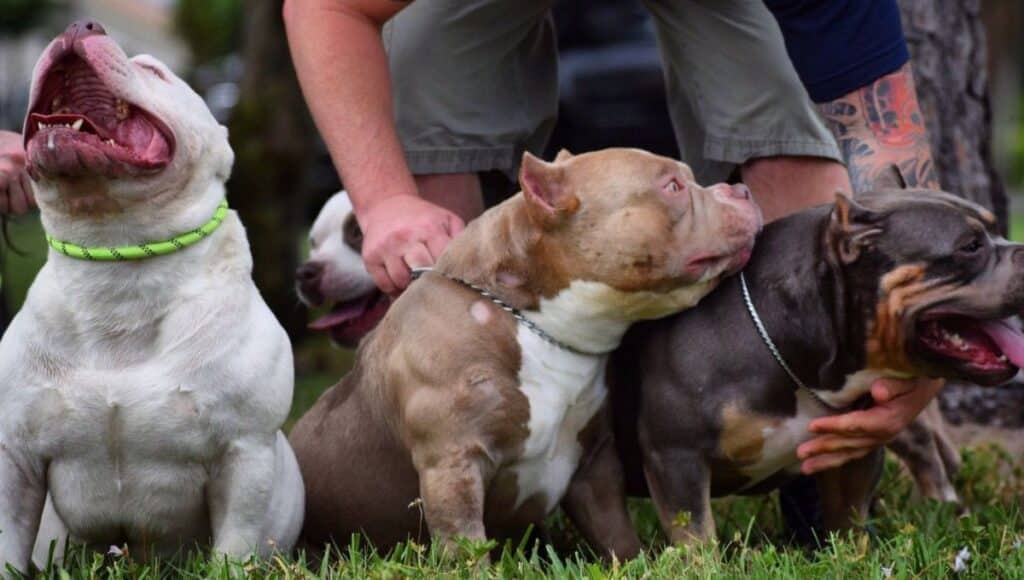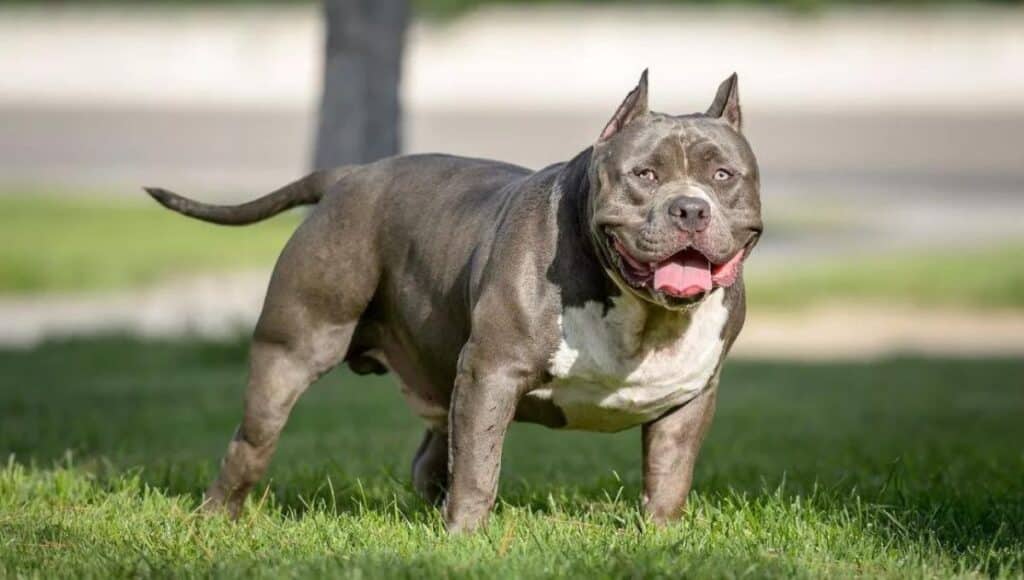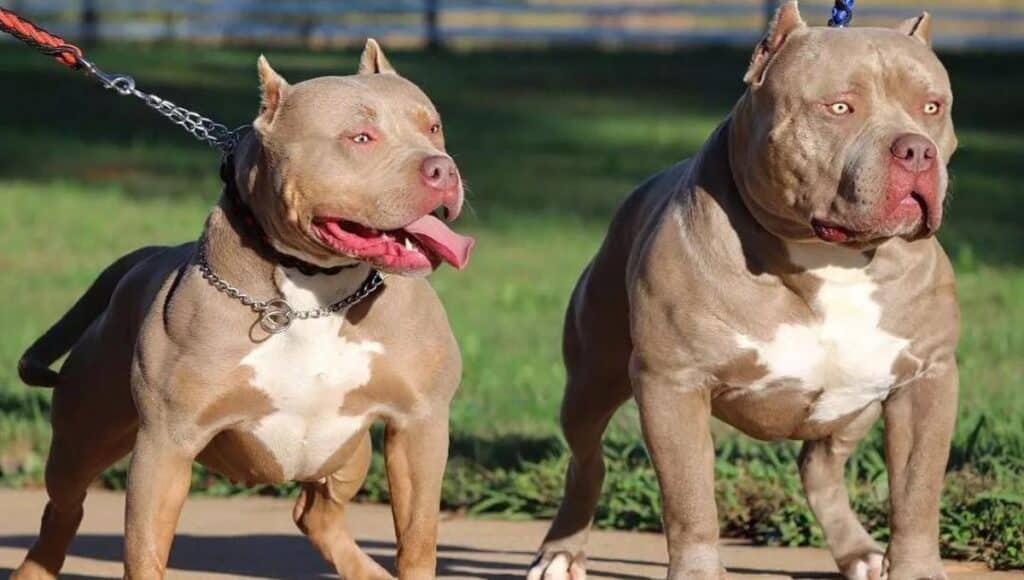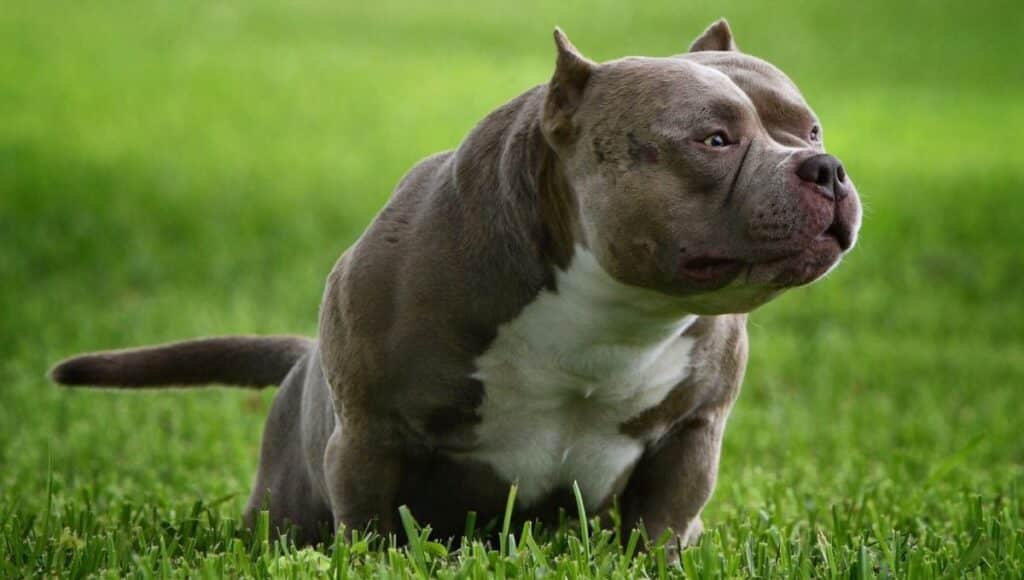Tired of playing guessing games with your American Bully’s growth? Is that cute lil’ fluffball hitting all the right numbers, or falling behind?
Let’s get real – having an undersized pup, especially a muscular breed like the Bully, can leave you worried sick. But no sweat, this guide’s got your back with the 411 on Bully growth stages and ideal sizes.
American Bully Growth Chart
Let’s start with the hard facts – here’s a handy chart mapping out the typical weight and height for Bully puppies month-by-month:
| Age | Weight | Height |
| 1 month | 5 – 8 lbs | 4 – 6 inches |
| 2 months | 8 – 15 lbs | 6 – 9 inches |
| 3 months | 12 – 25 lbs | 8 – 12 inches |
| 4 months | 16 – 35 lbs | 10 – 14 inches |
| 5 months | 20 – 45 lbs | 12 – 16 inches |
| 6 months | 30- 60 lbs | 14 – 18 inches |
| 7 months | 40 – 70 lbs | 16 – 20 inches |
| 8 months | 50 – 100 lbs | 18 – 22 inches |
| 9 months | 60 – 120 lbs | 20 – 23 inches |
| 10 months | 70 – 130 lbs | 21 – 23 inches |
| 11 months | 75 – 140 lbs | 21 – 23 inches |
| 12 month | 80 – 150 lbs | 21 – 23 inches |
American Bully Growth Stages

But growth charts only give you half the picture. Just like us, Bully puppies don’t sprout up at a steady, predictable rate. They’ve got distinct growth stages where changes hit ’em hard and fast.
0-4 Weeks
In their first month, Bully puppies are fragile lil’ beings totally reliant on mom for food, warmth, you name it. They’re basically blind for the first 3 weeks and sleep like…well, babies! Not much to report on the growth front yet.
1-2 Months
Once they hit 4-8 weeks, the real fun begins! Bully puppies start becoming more curious about the world, mimicking their siblings’ playful antics. Their eyes and ears kick into gear, so they can soak up all the new sights and sounds.
This is also when Bully owners start transitioning them to solid puppy foods. But don’t get overzealous with training or socialization yet – let those little fluff balls find their feet first.
2-3 Months
Around 8 weeks, Bully puppies are finally ready to head to their fur-ever homes! This is prime time for socialization and getting them used to new people, animals, and environments.
While puppyhood makes them bundles of energetic chaos, resist the urge to go overboard with play sessions or walks. Their lil’ joints and bones are still developing, so too much pressure can mess with their growth.
P.S. This is usually when their permanent coat colors start emerging – how cool is that?
3-4 Months
From 3-4 months, a Bully pup’s initial growth spurt slows down, though they’ll still seem to sprout before your eyes. Enjoy this “miniature dog” phase while it lasts – their puppy antics at this size are just too precious.
With all their senses properly calibrated, this stage is perfect for kick-starting training using positive reinforcement methods. Just be prepared for their infamous “teenaged” selective hearing!
4-6 Months
Buckle up, folks – the 4-6 month window is where Bully curiosity (and mischief!) peaks. These little explorers will constantly test boundaries, so consistent training and socialization are musts.
This stage is also when your pup may reach sexual maturity, bringing new…erm, behavioral quirks into the mix. Spaying or neutering, anyone? On a lighter note, you can start transitioning them to adult dog food now.
6-12 Months
By their first birthday, most Bully puppies have reached their full-grown size and the trademark muscular, stocky build. That said, their growth rate keeps gradually decreasing until it finally stops at around 12-14 months.
During this final stretch, keeping up a nutritious diet and ample exercise becomes crucial for achieving their ideal size and preventing weight issues.
Differences In American Bully Sizes
Whoa, back up – did you know there are actually different official size categories for American Bullies? Yup, it’s not just one-size-fits-all!
The tiny titans of the Bully world, Pocket Bullies are the smallest of the bunch. While not exactly “pocket-sized“, these compact cuties typically stand 13-17 inches tall, weighing a petite 10-20 lbs.
Don’t let the small stature fool you, though – Pocket Bullies still pack that signature muscular build into their portable frames.
Standard
Standard Bullies were the OGs, first bred in the 90s as a “refined” version of the classic Pitbull. With added muscle mass, blockier heads, and shorter legs, these Bullies look like they walked off a bodybuilding stage.
The ideal Standard lady measures 15-20 inches and tips the scales around 40-80 lbs, while the gents run 16-21 inches and can weigh up to 90 lbs of pure brawn.
Classic
At a glance, Classic Bullies could pass for their Standard counterparts since they fall in the same height range. The key difference? A lighter, more athletic build akin to the Pitbull breeds they descended from.
Despite the slimmer physique, Classics aren’t dramatically smaller than Standards – their weights just tend to skew a bit lower.
Xl Bully
Bringing up the rear (or should I say rump?) are the XL Bullies, true giants of the breed. These absolute units stand between 19-23 inches tall, with the girls weighing a solid 100-140 lbs and boys pushing 110-150 lbs of heft.
Yeah, they look intimidating, but don’t worry – XL Bullies were purpose-bred as family companions, so they’re actually big slobbery lovebugs under that muscle.
When Do American Bullies Stop Growing?

You’ve peeped the growth charts and stages, but when can you finally stop stressing over your Bully’s size? When do they wrap up their growth spurts for good?
For medium breed pooches like Bullies, the most intense growth happens in the first 6 months. After that initial explosion, they’ll keep inching upwards more gradually until topping out around 12-14 months old.
Now, that doesn’t mean their frames and muscles are 100% set in stone beyond the 1-year mark. A Bully’s build can still subtly transform with proper diet and conditioning. But any major weight fluctuations are cause for concern, so keep an eye out.
Factors That Affect American Bully’s Growth Rate
Just like with humans, there’s more than one factor governing how quickly (or slowly) a Bully pup packs on those pounds and inches. Let’s break it down:
Genetics
You know what they say – the apple doesn’t fall far from the tree! If your Bully’s parents were towering tanks themselves, chances are high that pup’s growth will follow the family footsteps.
Conversely, if mom and dad were runt-of-the-litter Lilliputians, you can expect your pupper to stay on the smaller side too. Some breeders offer genetic testing to clue you into your pup’s potential full-grown size.
Nutrition
Garbage in, garbage out – that’s just as true for Bullies as it is for us! Feeding your pal a nutritionally-balanced diet is crucial for achieving healthy growth rates and an ideal adult size.
Without sufficient proteins, fats, vitamins, and minerals from quality puppy food, your Bully’s development could stall or they could end up over/underweight. Too many calories is just as bad as not
Nutrition (Continued)
Without sufficient proteins, fats, vitamins, and minerals from quality puppy food, your Bully’s development could stall or they could end up over/underweight. Too many calories is just as bad as not enough, potentially leading to obesity and all the health issues that come along with it.
The key is striking that perfectly-balanced diet tailored to your pup’s age, activity levels, and individual needs. Working closely with your vet can help ensure you’re fueling your Bully for proper growth.
Physical Activity
Nutrition is crucial, but so is giving your fur baby enough daily exercise and activity for strong muscle and bone development. A sedentary pup is a sorry sight, missing out on achieving their full size potential.
Read This Blog
Health
Of course, you don’t want to overdo it either – too much high-impact stuff like running before their growth plates close can paradoxically stunt their growth. Moderation and low-impact play is best for the first year.
Sometimes, despite your best efforts, growth hiccups can happen due to underlying health conditions beyond your control. Nutrient deficiencies, hormonal imbalances, parasites – any of these could interfere with your Bully packing on those pounds and inches.
That’s why staying on top of vet checkups is so important, especially during those critical early stages. Catching any issues early can help get your pup’s growth back on track before it’s too late.
Plus, you’ll want to watch out for these common growth-related disorders that could affect the breed:
- Hip/elbow dysplasia
- Muscle wasting
- Bowed legs
- Abnormal posture
- Difficulty walking
Tips To Help Your Bully Grow

Okay, so your Bully seems to be lagging behind on hitting those weight/height milestones. Before you panic, there are some simple strategies you can try to give them a little nudge:
- Feed a high-quality puppy food formulated for larger breeds to meet their increased nutritional needs
- Ask your vet about safe supplements to promote healthy growth and development
- Stick to a consistent, moderate exercise routine involving daily walks and playtime
- Make sure your pup stays up-to-date on all required vaccines and deworming meds
- Be patient! Some Bullies just take their sweet time blossoming into their full size
The Importance Of Proper Development
While anxiously watching every growth spurt is understandable for a doting Bully owner, stressing over the numbers too much can backfire. More important than achieving a textbook “ideal” size is simply ensuring your pup’s growth unfolds at a healthy, sustainable pace.
Pushing them too hard with overfeeding, overexercising, or rushing major life events can seriously disrupt their biological development. This raises their risk of conformational issues, joint problems, and even behavioral issues down the road.
The wisest approach? Trust the process, follow your vet’s guidance, and let your Bully grow into their full glorious buff-ness in their own time. With patience and proper care, they’ll get there when they get there!
Respecting Your Bully’s Individual Journey
At the end of the day, there’s no such thing as a “perfect” growth trajectory that applies to every single Bully pup out there. Each one is a unique individual, shaped by their distinct genetic makeup, environment, and circumstances.
So while referencing breed standards and growth charts is helpful, don’t get too hung up on the numbers. Your furry friend may zag where you expect them to zig in terms of size…and that’s A-OK!
The goal should be appreciating your Bully for who they are, not stressing over who you think they “should” be. As long as they’re thriving and developing at a healthy rate overall, that’s what really matters most.
Conclusion
Stressing over whether your American Bully pup is the right size? Relax, every Bully grows at their own pace. But there are some general guidelines to keep an eye on. From newborn snooze-fests to the adventurous teen months, Bullies hit distinct growth stages.
Factors like genetics, nutrition, exercise, and health all impact their developing muscles and frames. Still, even if your pal’s a little spitfire or tank compared to breed standards, the most important thing is ensuring they grow at a healthy, sustainable rate.
With patience, proper care, and lots of love, your unique Bully will blossom into their full glorious self when the time is right. No sweat!







